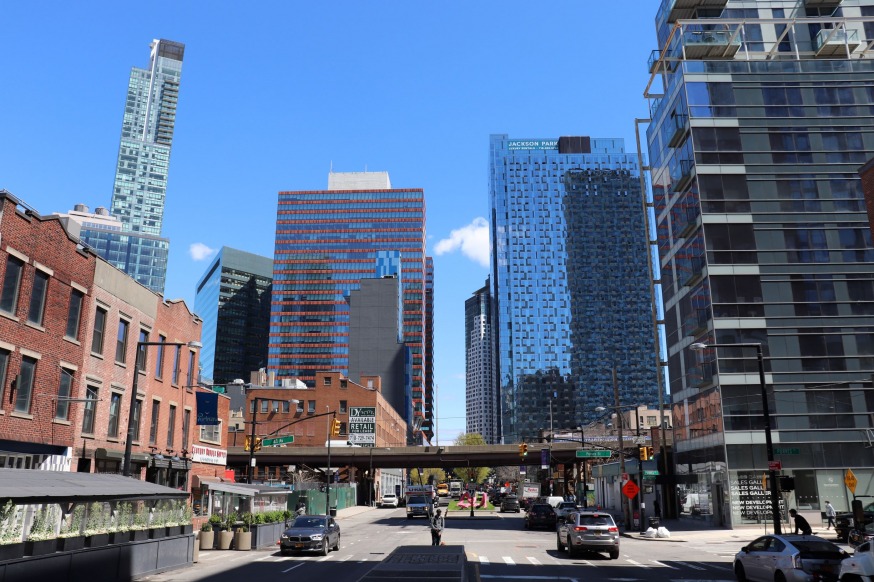
Jackson Avenue in Long Island City (Photo: Michael Dorgan, Queens Post)
April 16, 2021 By Allie Griffin
Thousands of residents fled western Queens in 2020 amid the COVID-19 pandemic, according to a report published by the real estate group CBRE.
The report — which analyzed 29 million USPS address changes across the nation — found that nationwide people last year vacated large, costly cities in much bigger numbers that in previous years.
The nationwide trend rocked New York City. When the city became the epicenter of the pandemic, New Yorkers left in massive numbers. The Big Apple was second only to San Francisco in terms of the number of people who left large cities last year.
In Queens, most neighborhoods lost residents in 2020. Though the same was true in 2019, the net losses were significantly higher.
Long Island City and Astoria saw a mass exodus last year, the report shows.
Taken together, more than 21,500 residents left the two neighborhoods in 2020. However, on a net basis– people moving in and out– the number approached 7,000.
Many large residential towers in Long Island City saw their occupancy rates plummet in 2020, The Real Deal reported in January.
For instance, the publication reported that the occupancy rate at the 1,871-unit Jackson Park development, located on Jackson Avenue in Long Island City, declined from 96 percent in 2019 to 59 percent in September 2020.
Nearby, Linc LIC, a 715-unit building at 43-10 Crescent Street, saw its occupancy rate decline from 91 percent in 2019 to 67 percent in the third quarter of 2020.
Spurred by the pandemic, many residents ended their leases and moved to suburbs with more outdoor space when the city was largely shuttered, according to the authors of the report. This trend, however, is beginning to reverse.
The Long Island City ZIP code of 11101 saw 6,783 people leave last year, more than any other ZIP code in the borough. Last year — accounting for those who moved into the area — the 11101 district lost 2,278 residents, more than any other ZIP code in Queens.
Both Long Island City and Astoria have a high percentage of adults in their 20s and 30s, census data shows. Many are young working professionals, a group prone to moving, according to the report.
“The increase in moves in 2020 was driven by young, affluent and highly educated urban dwellers,” the CBRE study states.
On the flip side, Breezy Point and neighborhoods in northeast Queens close to Long Island, saw either a net increase in new residents or little change at all. The areas are more suburban and the CBRE report found that most people who moved last year headed to the suburbs for more space.
“Most people who moved went to more suburban settings,” the report states. “What explains this trend? The difficulty of urban living amid social distancing is one reason, along with the mobility of young professionals who comprise a significant portion of urban populations.”
Most Queens residents didn’t move that far away. Nearly half moved to areas between 100 to 500 miles away, according to the report.
The ten ZIP codes below saw the greatest net loss of residents per capita in Queens last year.
11101: 4,505 people moved in and 6,783 people moved out for a net loss of 2,278 or 56 per 1,000 people in 2020 (compared to a net loss of 94 or 2 per 1,000 people in 2019)
11109: 983 people moved in and 1,361 people moved out for a net loss of 378 or 255 per 1,000 people in 2020 (compared to a net loss of 232 or 157 per 1,000 people in 2019)
11102: 2,311 people moved in and 3,460 people moved out for a net loss of 1,149 or 31 per 1,000 people in 2020 (compared to a net loss of 390 or 10 per 1,000 people in 2019)
11103: 2,362 people moved in and 3,563 people moved out for a net loss of 1,201 or 31 per 1,000 people in 2020 (compared to a net loss of 510 or 13 per 1,000 people in 2019)
11105: 2,249 people moved in and 2,975 people moved out for a net loss of 726 people or 19 per 1,000 people in 2020 (compared to a net loss of 314 or 8 per 1,000 people in 2019)
11106: 2,242 people moved in and 3,441 people moved out for a net loss of 1,199 or 29 per 1,000 people in 2020 (compared to a net loss of 437 or 10 per 1,000 people in 2019)
11104: 1,508 people moved in and 2,170 people moved out for a net loss of 662 or 24 per 1,000 people in 2020 (compared to a net loss of 295 or 10 per 1,000 people in 2019)
11377: 3,260 people moved in and 4,745 people moved out for a net loss of 1,485 or 16 per 1,000 people in 2020 (compared to a net loss of 1,156 or 12 per 1,000 people in 2019)
11385: 3,736 people moved in and 5,477 people moved out for a net loss of 1,741 or 17 per 1,000 people in 2020 (compared to a net loss of 1,036 or 10 per 1,000 people in 2019)
11415: 854 people moved in and 1,166 people moved out for a net loss of 312 or 16 per 1,000 people in 2020 (compared to a net loss of 300 or 15 per 1,000 people in 2019)
The CBRE analysis was first reported by Patch.
